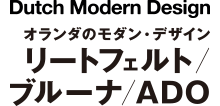展覧会についてExhibition
Gerrit Thomas Rietveld (1888-1964)
Revolutionary Red Blue Chair
Rietveld, dissatisfied with traditional furniture that symbolised wealth, joined “De Stijl” (1917-32), the avant-garde art movement whose founders included Piet Mondrian, as part of an attempt to explore new furniture and architecture appropriate for truly contemporary living. De Stijl aimed to create a new environment using the most fundamental visual elements, primary colours and straight lines. Rietveld’s famous Red Blue Chair (c. 1918–23) used the De Stijl colour palette, but the chair already stood out for its structure with unique joints where members intersected alternately. Through this chair, Rietveld was developing a new concept for furniture and his own distinctive approach to space that later extended to his architectural work.
Avant-garde abstract space and simple hand-made approach
Rietveld’s first whole architectural commission, the Rietveld Schröder House (1924), made elements such as walls and windows intersect each other alternately, and made fluid boundaries between inside and out, renouncing the box-shape of conventional architecture that surrounded each space. Through this approach, he created a completely new space that was free and open. At the same time, in this small, low-cost house, he created a space that would accord with the wishes of the recently-widowed owner, Mrs. Truus Schröder-Schräder, to share a rewarding life with her three children, to which end she worked on the design together with Rietveld. The space provided the flexibility to meet the various needs of a growing family, a balance between privacy and togetherness, simple functionality, and harmony with nature. Combined with the ideas evident throughout the house that drew on the architect’s expertise as a furniture craftsman, this design provided a vision of a new approach to living that is still relevant today. Rietveld’s unique attitude to manufacture achieved a surprisingly progressive result from his simple but warm handmade approach, and even today, this makes a particularly strong impression on visitors to the house.







